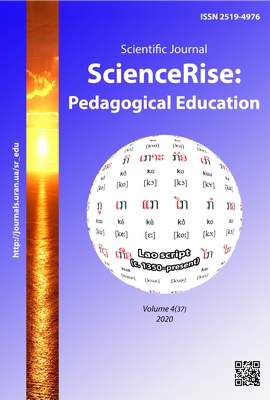Creating ESP classroom culture based on student-generated ideas
DOI:
https://doi.org/10.15587/2519-4984.2020.202013Keywords:
student-generated, autonomy, definition games, HOTs and LOTs questions, Quizlet, Classtime, feedbackAbstract
The article deals with the problem of transforming the traditional educational environment and creating classroom culture, which is based on the ideas of students, who study English for Specific Purposes. This study was conducted at the National Technical University of Ukraine «Igor Sikorsky Kyiv Polytechnic Institute». ESP students, majoring in Information Technology, Mathemathics or Physics, ranged between 18 and 20 years of age, were enrolled in the first and the second year of study. A mixed methods research design was used to collect data in order to define ESP students’ attitude towards suggested ways of engaging them into generating activities: surveys, which contained open questions, interviews and discussions, conducted on a voluntary basis. The feedback from 42 students was collected during practical classes in February at the beginning of the second semester of 2019-2020 academic year. The article states that introducing changes in ESP classroom gradually, HOTs and LOTs questions, definition games, Quizlet and Classtime, various kinds of feedback allowed teachers to build the environment, based on student-generated ideas, which provided opportunities for developing student autonomy, indicated a shift from teacher-centered class, satisfied the need of social contact and collaboration. Thus, creating their own materials turns students into active participants, who, being interested in purposeful communication, design ESP activities. Teachers become facilitators, who monitor classroom activities and assist students in creating ESP classroom culture, based on student-generated ideas. The results of the study will be valuable for ESP practitioners, who would like to introduce changes into a traditional class and make it student-centered. Further investigations should be devoted to adding other ways of engaging students into generating ideas for the ESP classes and analyzing the results of their practical implementation
References
- Chugai, O., Terenko, O., Ogienko, O. (2017). Methods that work: best practices of adult educators in the USA. Advanced Education, 4 (8), 72–77. doi: http://doi.org/10.20535/2410-8286.109216
- Bolitho, R., West, R. (2017). The internationalisation of Ukrainian universities: the English language dimension: British Council, Ukraine English for Universities Project. Available at: http://www.britishcouncil.org.ua/sites/default/files/2017-10-04_ukraine_-_report_h5_en.pdf
- Little, D. (1991). Learner Autonomy 1: Definitions, Issues and Problems. Dublin: Authentik. Available at: https://www.researchgate.net/publication/259874253
- Ariffin, S. A., Sidek, S. F., Mutalib, M. F. (2018). Preliminary Descriptive Insights into Student Generated Activities for STEM subjects through Mobile Learning in a Malaysian University Context. International Journal of Academic Research in Business and Social Sciences, Human Resource Management Academic Research Society, International Journal of Academic Research in Business and Social Sciences, 8 (2), 523–534. Available at: https://ideas.repec.org/a/hur/ijarbs/v8y2018i2p523-534.html
- Stavytska, I. (2017). The formation of foreign language competence of engineering students by means of multimedia. Advanced Education, 3 (7), 123–128. doi: http://doi.org/10.20535/2410-8286.95301
- Peterson, A., Dumont, H., Lafuente, M., Law, N. (2018). Understanding innovative pedagogies: key themes to analyze new approaches to teaching and learning. OECD Education Working Paper No. 172. Available at: http://www.oecd.org/officialdocuments/publicdisplaydocumentpdf/?cote=EDU/WKP(2018)8&docLanguage=En
- Kiszczak, A. (2016). The Learning Potential of Study Questions in TEFL Textbooks. Working with Text and Around Text in Foreign Language Environments. Springer, 57–73. doi: http://doi.org/10.1007/978-3-319-33272-7_4
- Scrivener, J. (2015). Learning teaching. Macmillan Education. Available at: https://archive.org/stream/LearningTeachingJ.ScrivenerCopy/Learning%20Teaching-%20J.%20Scrivener_djvu.txt
- Tkachova, N., Tur, O. (2017). Didactic game as an advanced method of communicative competence formation in future specialists in documentation and information services. Advanced Education, 3 (7), 141–145. doi: http://doi.org/10.20535/2410-8286.90021
- Fuentes, S.Q. (2011). A Lesson Based on Student-Generated Ideas: A Practical Example Highlighting the Role of a Teacher. IUMPST: The Journal, 2 (Pedagogy). Available at: http://www.k-12prep.math.ttu.edu/journal/2.pedagogy/fuentes01/article.pdf
- Rothstein, D., Santana, L. (2011). Make just one change: Teach Students to Ask their own questions. Cambridge: Harvard Education Press, 192.
- Ciantar, A., Eesmaa, I., Milana, M., Lund, L. S., Valgmaa, R.; Jääger, T. (Ed.) (2010). The art of being an adult educator. BAEA Becoming Adult Educators in the European Area. Copenhagen: Danish School of Education, 60. Available at: https://www.academia.edu/784439/The_art_of_being_an_adult_educator
- Brookfield, S. D. (2015). The skilful teacher. Wiley. Available at: https://www.ebooks.com/en-ua/book/1895929/the-skillful-teacher/stephen-d-brookfield/?_c=1
Downloads
Published
How to Cite
Issue
Section
License
Copyright (c) 2020 Nataliia Saienko, Oksana Chugai

This work is licensed under a Creative Commons Attribution 4.0 International License.
Our journal abides by the Creative Commons CC BY copyright rights and permissions for open access journals.
Authors, who are published in this journal, agree to the following conditions:
1. The authors reserve the right to authorship of the work and pass the first publication right of this work to the journal under the terms of a Creative Commons CC BY, which allows others to freely distribute the published research with the obligatory reference to the authors of the original work and the first publication of the work in this journal.
2. The authors have the right to conclude separate supplement agreements that relate to non-exclusive work distribution in the form in which it has been published by the journal (for example, to upload the work to the online storage of the journal or publish it as part of a monograph), provided that the reference to the first publication of the work in this journal is included.








